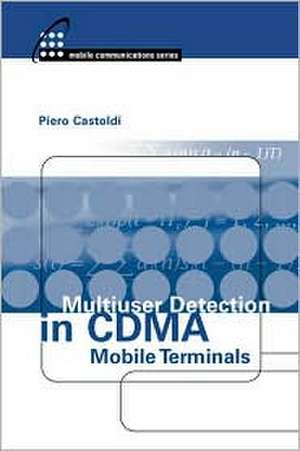Multiuser Detection in Cdma Mobile Terminals: Artech House Mobile Communications
Autor Piero Castoldien Limba Engleză Hardback – 31 mai 2002
Din seria Artech House Mobile Communications
- 14%
 Preț: 950.86 lei
Preț: 950.86 lei - 14%
 Preț: 967.50 lei
Preț: 967.50 lei - 14%
 Preț: 767.41 lei
Preț: 767.41 lei - 14%
 Preț: 872.93 lei
Preț: 872.93 lei - 14%
 Preț: 783.77 lei
Preț: 783.77 lei - 14%
 Preț: 767.97 lei
Preț: 767.97 lei - 14%
 Preț: 874.28 lei
Preț: 874.28 lei - 14%
 Preț: 848.75 lei
Preț: 848.75 lei - 14%
 Preț: 856.42 lei
Preț: 856.42 lei - 14%
 Preț: 1021.19 lei
Preț: 1021.19 lei - 14%
 Preț: 946.70 lei
Preț: 946.70 lei - 11%
 Preț: 532.96 lei
Preț: 532.96 lei - 11%
 Preț: 584.87 lei
Preț: 584.87 lei - 14%
 Preț: 981.88 lei
Preț: 981.88 lei - 14%
 Preț: 836.52 lei
Preț: 836.52 lei - 11%
 Preț: 702.08 lei
Preț: 702.08 lei - 14%
 Preț: 839.81 lei
Preț: 839.81 lei - 14%
 Preț: 890.27 lei
Preț: 890.27 lei - 11%
 Preț: 669.99 lei
Preț: 669.99 lei - 14%
 Preț: 828.64 lei
Preț: 828.64 lei - 14%
 Preț: 911.02 lei
Preț: 911.02 lei - 11%
 Preț: 687.14 lei
Preț: 687.14 lei - 11%
 Preț: 484.08 lei
Preț: 484.08 lei - 18%
 Preț: 678.85 lei
Preț: 678.85 lei - 11%
 Preț: 602.35 lei
Preț: 602.35 lei -
 Preț: 224.51 lei
Preț: 224.51 lei - 18%
 Preț: 640.93 lei
Preț: 640.93 lei - 11%
 Preț: 490.86 lei
Preț: 490.86 lei - 14%
![Quantitative Analysis of Cognitive Radio and Network Performance [With DVD]](https://i3.books-express.ro/bs/9781608070985/quantitative-analysis-of-cognitive-radio-and-network-performance-with-dvd.jpg) Preț: 837.97 lei
Preț: 837.97 lei -
 Preț: 399.18 lei
Preț: 399.18 lei -
 Preț: 450.90 lei
Preț: 450.90 lei -
 Preț: 205.40 lei
Preț: 205.40 lei - 18%
 Preț: 710.10 lei
Preț: 710.10 lei - 15%
 Preț: 480.68 lei
Preț: 480.68 lei -
 Preț: 436.10 lei
Preț: 436.10 lei - 18%
 Preț: 678.81 lei
Preț: 678.81 lei - 18%
 Preț: 549.54 lei
Preț: 549.54 lei - 11%
 Preț: 638.46 lei
Preț: 638.46 lei - 15%
 Preț: 491.86 lei
Preț: 491.86 lei - 20%
 Preț: 949.82 lei
Preț: 949.82 lei -
 Preț: 152.00 lei
Preț: 152.00 lei - 18%
 Preț: 771.45 lei
Preț: 771.45 lei - 14%
 Preț: 718.20 lei
Preț: 718.20 lei -
 Preț: 441.69 lei
Preț: 441.69 lei - 18%
 Preț: 511.59 lei
Preț: 511.59 lei - 14%
 Preț: 731.86 lei
Preț: 731.86 lei - 11%
 Preț: 610.31 lei
Preț: 610.31 lei -
 Preț: 121.91 lei
Preț: 121.91 lei - 20%
 Preț: 337.04 lei
Preț: 337.04 lei
Preț: 676.04 lei
Preț vechi: 786.09 lei
-14% Nou
Puncte Express: 1014
Preț estimativ în valută:
129.35€ • 135.07$ • 106.82£
129.35€ • 135.07$ • 106.82£
Carte indisponibilă temporar
Doresc să fiu notificat când acest titlu va fi disponibil:
Se trimite...
Preluare comenzi: 021 569.72.76
Specificații
ISBN-13: 9781580533300
ISBN-10: 1580533302
Pagini: 227
Dimensiuni: 161 x 234 x 21 mm
Greutate: 0.52 kg
Ediția:New.
Editura: Artech House Publishers
Seria Artech House Mobile Communications
ISBN-10: 1580533302
Pagini: 227
Dimensiuni: 161 x 234 x 21 mm
Greutate: 0.52 kg
Ediția:New.
Editura: Artech House Publishers
Seria Artech House Mobile Communications
Cuprins
Preface. Introduction and CDMA Models – Multiple Access Techniques. Code Division Multiple Access. Spread Spectrum Techniques for CDMA. Short Codes vs. Long Codes: Orthogonal vs. Random Spreading. Synchronous CDMA. Asynchronous CDMA. Dicotomies in CDMA. Single-User Detection – Single-User vs. Multiuser Receivers. Performance Measures of CDMA Receivers. The Conventional Receivers. The Rake Receiver. Limits of Single-User Detection. Linear Multiuser Detection – Synchronous CDMA, Short Code, Multipath, Multirate. Sliding Window Linear Detectors. MMSE Receivers for CDMA Asynchronous Systems. Sliding Window MMSE Receiver. Considerations on Linear Detection. Structured vs. Unstructured Linear Detection and Interference Mitigation – System Model. Linear Receivers. Sliding Window Receiver. Typical Operating Modes of the Linear Receivers. Multiuser Detection vs. Interference Mitigation. Adaptive Linear Multiuser Detection – Adaptive MMSE Receivers. Trained Adaptive MMSE Receiver. Blind Adaptive MMSE Receiver. Blind Adaptive MMSE Receiver with Surplus Energy Constraint. Advantages of Adaptive Linear Detection. Performance of Linear Multiuser Detection – Performance of the ZF and MMSE Receivers in Synchronous Systems: BER and BEP Performance in a Single-Cell and Multiple Cell Scenario. Performance of the MMSE Receivers in Asynchronous Systems: Transient Performance of Adaptive Receivers; BER Performance in the Ideal Case, in the Presence of Phase Offset, Frequency Offset and Timing Error. Non-Linear Multiuser Detection – Non-Linear Detection Fundamentals. Observation model. Successive Interference Cancellation (SIC). Parallel Interference Cancellation (PIC). Decision Feedback Non-Linear Receivers. Linear vs. Non-Linear Multiuser Detection.Synchronization Techniques - Observation Model. Timing Acquisition. Performance of the Sliding Correlator. Frequency Offset Estimation. Performance of the Linear Frequency Estimator. Coherent Vs. Non Coherent Detection. Third Generation Mobile Radio System ‑ General Specifications. The Physical Layer of the TDD-HCR Mode. Transmission Scheme and Transmitted Signal. Cell Search and Synchronization. Novelties of the Third Generation Radio System. The ASI-CNIT Communication System. – System Description. Data Frame Format. Algorithms For Data Detection and their Performance. Optimization of the Length of the Training Sequence. Signaling Using the Synchronization Sequence.
